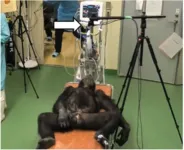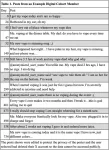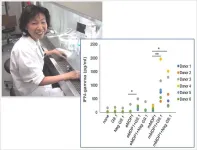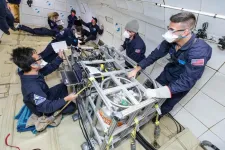A novel signal-amplification system utilizing sumanene-based supramolecular polymers
Researchers propose a new way for signal-amplification of chemosensors by flexibly manipulating an allosteric trigger
2024-06-19
(Press-News.org)
Chemical sensors whose signals can be amplified by various triggers hold huge potential in multidisciplinary sciences. However, developing such systems was considered a highly challenging task, until a team of researchers from Tokyo Tech recently came up with a novel signal-amplification system that can be flexibly manipulated by a dynamic allosteric effector or a trigger. This new chemosensor system exhibited exception signal amplification by altering the sumanene monomer concentrations.
Synthetic supramolecular hosts and artificial receptors have found an exciting application in the form of chemical sensors or chemosensors, which hold the potential to change the field of molecular recognition and real-time biomedical sensing. They are based on the fundamental lock-and-key working principle where a specific chemical substrate perfectly fits into the active site of an enzyme (host), thus, leading to a specific chemical reaction that creates a signal necessary for sensing purposes.
The lock-and-key model, however, has its share of disadvantages, and an effective way to deal with them is to enhance the signal by improving the binding constant between the host and the target molecule. Biological systems are known to amplify their binding constant via a process known as allosterism. To ensure that the chemosensor is more sensitive and efficient, scientists have been looking for ways to amplify the signal and are on the lookout for signal-amplifying chemosensors that can be manipulated by various allosteric effectors or triggers.
To aid this effort, researchers from Tokyo Institute of Technology(Tokyo Tech), led by Associate Professor Gaku Fukuhara, in collaboration with Osaka University, presented in a recent Scientific Reports study published on 31 May 2024, the discovery of a new nature-surpassed signal-amplification system that can be flexibly manipulated by a dynamic allosteric effector or trigger.
“Supramolecular polymers consist of a functional monomer that spontaneously stacks on each other through noncovalent interactions. It is assumed that the degree of polymerization can be manipulated by changing the monomer concentration. We used this knowledge to make dynamic changes in the allosteric effector,” replied Fukuhara when asked about their modus operandi.
For the first time, the team obtained an allosteric trigger using curved-π buckybowl sumanene as the monomer for supramolecular polymerization. They also incorporated a sumanene-based chemosensor (SC) into the system due to sumanene’s ability to spontaneously polymerize as supramolecules in solutions. Additionally, the pristine sumanene molecule is known to gradually stack on the convex face of the chemosensor to form hetero-supramolecular polymers (SC·(sumanene)n), which the researchers found was also responsible for the degree of signal-amplification.
The team also found that the degree of polymerization could be changed by controlling the degree of monomer effector and subsequent flexible manipulation of electronic properties at the binding site. The exceptional signal-amplification system exhibited by the system could be attributed to the fluorescence changes upon the complexation of guest molecules.
To test the applicability of the system on biologically important materials and generalize the current signal-amplification method, the team used steroids like testosterone, corticosterone, and allylestrenol as target molecules. The experiments revealed that changing the sumanene monomer concentration led to a 62.5-fold signal amplification of a steroid.
The sensing strategy proposed in this study can act as a guideline for further development of sensors for diverse guests that are difficult to recognize via use of conventional lock-and-key type chemosensors. “Our chemosensor system is a powerful tool that demonstrated the effectiveness of supramolecular polymerization adjustments as a mode of manipulation signal amplification. It can thus open new avenues for the development of alternate chemosensors and signal-amplification systems triggered by various triggers,” concludes Fukuhara.
###
About Tokyo Institute of Technology
Tokyo Tech stands at the forefront of research and higher education as the leading university for science and technology in Japan. Tokyo Tech researchers excel in fields ranging from materials science to biology, computer science, and physics. Founded in 1881, Tokyo Tech hosts over 10,000 undergraduate and graduate students per year, who develop into scientific leaders and some of the most sought-after engineers in industry. Embodying the Japanese philosophy of “monotsukuri,” meaning “technical ingenuity and innovation,” the Tokyo Tech community strives to contribute to society through high-impact research.
https://www.titech.ac.jp/english/
END
ELSE PRESS RELEASES FROM THIS DATE:
2024-06-19
An innovative synthesis strategy opened up the way to 2D/3D fused frameworks using inexpensive quinolines as feedstock, report scientists from Tokyo Tech. By leveraging a light-sensitive borate intermediate, the scientists could transform quinoline derivatives into a great variety of 2D/3D fused frameworks in a straightforward and cost-effective manner. Their findings are expected to enable the synthesis of highly customizable drug candidates.
Quinolines have garnered much attention from chemists wanting to synthesize compounds known as 2D/3D fused frameworks. These complex organic molecules have a lot of medical potential due to their highly ...
2024-06-19
Measuring the heart rate of great apes in captivity is essential for both health management and animal studies. However, existing most methods are either invasive or inaccurate. Now, researchers from Japan have investigated the potential of using millimeter-wave radar technology to estimate heart rate from subtle body movements in chimpanzees. Their efforts will hopefully pave the way to better practices and techniques for monitoring heart rates in wild and captive primates.
Just like in humans, heart rate is a critically important and informative vital sign in nonhuman primates. Heart diseases are among the main causes ...
2024-06-19
Tapping into the vast amount of data now available on social media, a new study from scientists at the University of California San Diego introduces a powerful new approach to understanding the nation’s health, in this case the vaping epidemic.
The study, published in the American Journal of Preventive Medicine on June 19, was led by John W. Ayers, Ph.D., from the Qualcomm Institute within UC San Diego.
“Researchers studying social media have tended to analyze the frequency and content of posts,” said Ayers, who is deputy director of informatics at the Altman Clinical and Translational Research Institute, vice chief of innovation in the Division of Infectious ...
2024-06-19
Niigata, Japan - Tuberculosis is still one of the deadliest infectious diseases, causing over one million deaths each year worldwide. Additionally, about one-fourth of the world's population carries Mycobacterium tuberculosis (M. tuberculosis) without showing any symptoms, and most of these carriers do not develop the disease.
The current anti-tuberculosis vaccine, BCG, is administered worldwide. However, considering that more than 10 million new tuberculosis cases are reported each year, its effectiveness is deemed ...
2024-06-19
USC recently hosted its first Music, Health, and Policy workshop as part of Los Angeles County Arts and Health Week, filling Joyce J. Cammilleri Hall on the University Park Campus.
Event organizer Assal Habibi, an associate professor at the Brain and Creativity Institute at the USC Dornsife College of Letters, Arts and Sciences who explores the intersection between music and the human brain, brought together a wide range of experts on the importance of art and its effect on human development and well-being.
“The workshop aims to bring people together ...
2024-06-19
A private (fee-paying) school and/or a ‘higher status’ (Russell Group*) university education may be linked to better mid-life health—at least in the UK—suggests research published online in the Journal of Epidemiology & Community Health.
Alongside the level of education achieved, the type of educational institution a person attends may also influence subsequent health outcomes, suggest the researchers.
Published research to date indicates that educational attainment is associated with better subsequent health. But other aspects ...
2024-06-19
Twelve months of heavy resistance training—exercise that makes muscles work against a force—around retirement preserves vital leg strength years later, show the follow up results of a clinical trial, published online in the open access journal BMJ Open Sport & Exercise Medicine.
Depletion of leg muscle strength is regarded as a strong predictor of death in older people, so is important to maintain, say the researchers.
Skeletal muscle mass and function naturally decline with advancing age, ultimately often interfering with mobility and autonomy in older people, note the researchers.
Resistance training, which ...
2024-06-19
A multi-institutional study led by University of Illinois and Agroecosystem Sustainability Center (ASC) scientists concluded that, although soil moisture varies significantly both within a single field and from field to field due to varying soil properties and different management practices, soil moisture distribution relative to the field average remains consistent across time within each field.
Over three years, the team used sensor measurements and a high-density campaign to reveal that the drier areas remain the drier areas and the wetter areas remain the wetter areas. The study also deduced this finding, reliable estimations of ...
2024-06-19
The severity of anxiety and depressive symptoms in the planetary science community is greater than in the general U.S. population, according to a study led by a University of Hawai‘i at Mānoa scientist and published this week in Nature Astronomy.
“After reading about so much anxiety and depression in academia, and as someone who loves both planetary science and psychology, I felt like I needed to do something because there are so many people suffering,” said David Trang, an assistant researcher in the Hawai‘i Institute of Geophysics and Planetology in the UH Mānoa School of Ocean and Earth Science and Technology at the ...
2024-06-19
As space travel becomes more common, it is important to consider the impacts of space flight and altered gravity on the human body. Led by Dr. Ana Diaz Artiles, researchers at Texas A&M University are studying some of those impacts, specifically effects on the eye.
Gravitational changes experienced by astronauts during space travel can cause fluids within the body to shift. This can cause changes to the cardiovascular system, including vessels in and around the eyes.
As the commercialization of space flight becomes more common and individual space travel increases, astronauts will not be the ...
LAST 30 PRESS RELEASES:
[Press-News.org] A novel signal-amplification system utilizing sumanene-based supramolecular polymers
Researchers propose a new way for signal-amplification of chemosensors by flexibly manipulating an allosteric trigger








